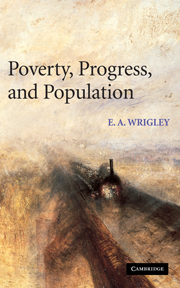Book contents
- Frontmatter
- Contents
- List of figures
- List of tables
- Acknowledgements
- Introduction
- PART I The wellsprings of growth
- PART II Town and country
- PART III The numbers game
- 12 Explaining the rise in marital fertility in England in the ‘long’ eighteenth century
- 13 No death without birth: the implications of English mortality in the early modern period
- 14 The effect of migration on the estimation of marriage age in family reconstitution studies
- 15 Demographic retrospective
- Bibliography
- Index
14 - The effect of migration on the estimation of marriage age in family reconstitution studies
Published online by Cambridge University Press: 23 December 2009
- Frontmatter
- Contents
- List of figures
- List of tables
- Acknowledgements
- Introduction
- PART I The wellsprings of growth
- PART II Town and country
- PART III The numbers game
- 12 Explaining the rise in marital fertility in England in the ‘long’ eighteenth century
- 13 No death without birth: the implications of English mortality in the early modern period
- 14 The effect of migration on the estimation of marriage age in family reconstitution studies
- 15 Demographic retrospective
- Bibliography
- Index
Summary
Use of the technique of family reconstitution has provided a wealth of new information about the demography of communities in the past. In spite of this, there has long been a question mark hanging over reconstitution studies because of a particular problem, sometimes referred to as the problem of the reconstitutable minority. Even though it may be possible to obtain unusually detailed information about the lives of some of the inhabitants of a parish in the past, there will always be many others about whom little can be known, at least without the extreme labour of reconstituting a large block of adjacent parishes in order to reduce the problem of ‘escapes’ through migration.
The problem stems from a feature of reconstitution that is at once a strength and a weakness. Louis Henry turned the product of genealogical work into a source of precise and detailed demographic information by defining clearly the period of time during which an individual who appears on a family reconstitution form(FRF) may properly be regarded as at risk to give birth, to marry, or to die, and thus enabled exact measurements of fertility, nuptiality, and mortality to be made. This constitutes one of the main strengths of family reconstitution. It is balanced by the fact that the accurate definition of periods of risk demonstrated equally clearly that, at least in places where there was a high level of migration into and out of the parish, many individuals who spent part of their lives in a parish could not be regarded as in observation for demographic purposes for much of their sojourn in the parish, and might indeed never enter observation at all.
- Type
- Chapter
- Information
- Poverty, Progress, and Population , pp. 367 - 393Publisher: Cambridge University PressPrint publication year: 2004



